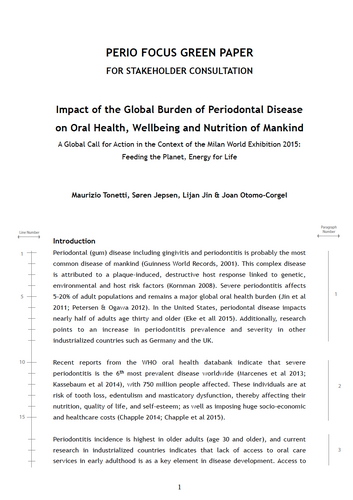![]()
9 January 2016
Comments are invited on green paper which calls for global action on prevention, diagnosis, and treatment of periodontal diseases
Category:Science

An international group of leading periodontologists has issued a call to action on periodontal diseases, publishing the “Perio Focus green paper”, which seeks to create a new global consensus around periodontology.
Entitled Impact of the global burden of periodontal disease on oral health, well-being and nutrition of mankind, the green paper was written by Journal of Clinical Periodontology editor Maurizio Tonetti and EFP president Søren Jepsen, together with Li-Jian Jin, councillor of the Asian Pacific Society of Periodontology (APSP) and Joan Otomo-Corgel, immediate past president of the American Academy of Periodontology (AAP).
The document was drawn up for the Milan World Exhibition 2015, which ran from May to October, devoted to the theme of “Feeding the Planet, Energy for Life”.
The Perio Focus green paper says that periodontology is “supported by a strong and coherent body of evidence that allows identification of appropriate preventive, diagnostic and therapeutic strategies to manage the enormous burden of disease represented by periodontitis [and] its health, well-being, social, and economic consequences.”
It notes World Health Organization (WHO) estimates that severe periodontitis is the sixth most prevalent disease worldwide, affecting more than 750 million people and imposing significant healthcare and socio-economic costs.
The document highlights three areas for action:
1.- Prevention: Periodontitis is preventable through effective management of gingivitis and the promotion of healthy lifestyles at both population and individual levels. Prevention needs to be tailored to individual needs through diagnosis and risk-profiling.
The conclusions of the XI European Workshop in Periodontology (the EFP Prevention Workshop) “have helped to identify potential large-scale preventive programmes and highlighted specific actions that may reduce the worldwide prevalence of periodontal disease.”
Given the risk factors which periodontitis shares with other major chronic inflammatory diseases such as heart disease and diabetes, the WHO Common Risk Factor Approach (CRFA) to improving health should advocate self-performed oral hygiene as a positive lifestyle.
2.- Diagnosis: Periodontitis is easily diagnosed via a comprehensive full-mouth periodontal evaluation and periodontal probing should be a key component of every dental visit. There should be a three-step approach to diagnosis: (1) patient self-detection of symptoms and signs of disease; (2) professional periodontal screening to segment the population into three groups – periodontal health, gingivitis, periodontitis; (3) comprehensive periodontal examination and diagnosis to plan appropriate treatment of periodontitis.
3.- Treatment: There is overwhelming evidence that periodontitis can be treated and effectively managed in most cases. Delivery of appropriate periodontal care to the individual patient requires a full diagnostic and prognostic assessment, and access to effective treatments able to control inflammation and avoid tooth loss.
A series of specific actions at national level is needed to improve access to available care. This includes improving public and professional awareness of periodontal diseases and treatment options, and of the potential saving to dental and medical care that can be achieved with appropriate periodontal treatment.
Comment is now invited from individual periodontologists, general dentists, oral-health professionals, national periodontal societies, dentistry-related bodies, patient groups, medical professionals, and other relevant third parties from across the globe. As well as the EFP, the AAP and the APSP, active feedback will be sought from the Ibero-Panamerican Federation of Periodontics (FIPP) and the World Health Organization (WHO), among others.
EFP-affiliated national societies and their individual members are encouraged to read the green paper and to provide comments and suggest changes. Contributions should state clearly the paragraph and sentence where additions, amendments, or deletions are proposed.
Contributions should be sent to greenpaper@efp.org before April 1, 2016, indicating the name and country of the contributing person or national perio society. All comments will be considered and carefully assessed by the paper’s primary authors, who will decide upon their inclusion in the final document. An appendix will be published online which will include all submissions.
The final draft will be shared with the EFP, the AAP, the APSP, and the FIPP, and then submitted for publication in the Journal of Clinical Periodontology.
The full green paper is available here.




